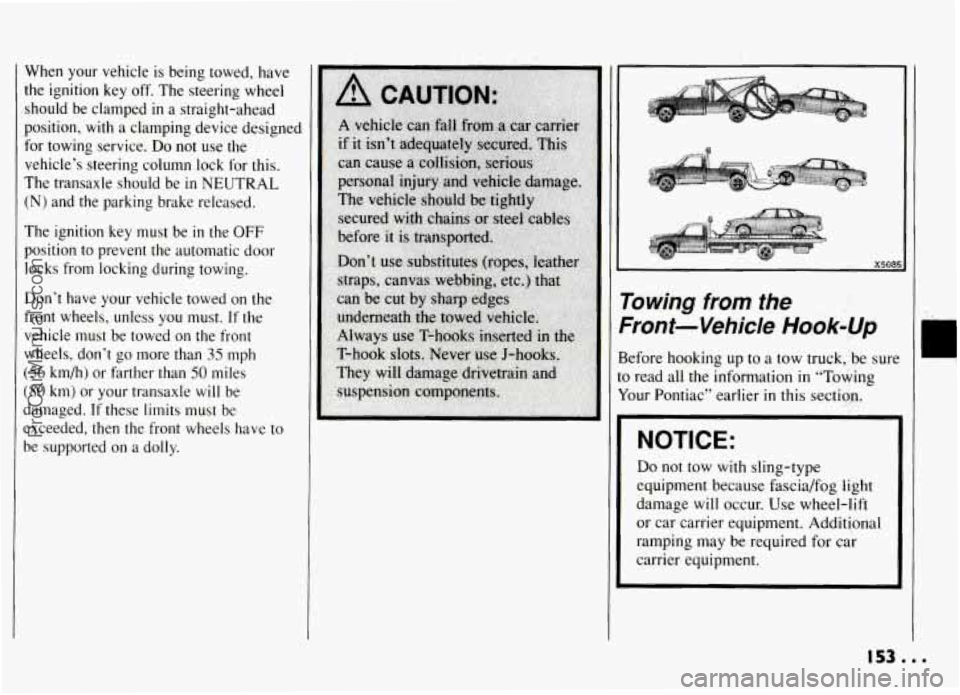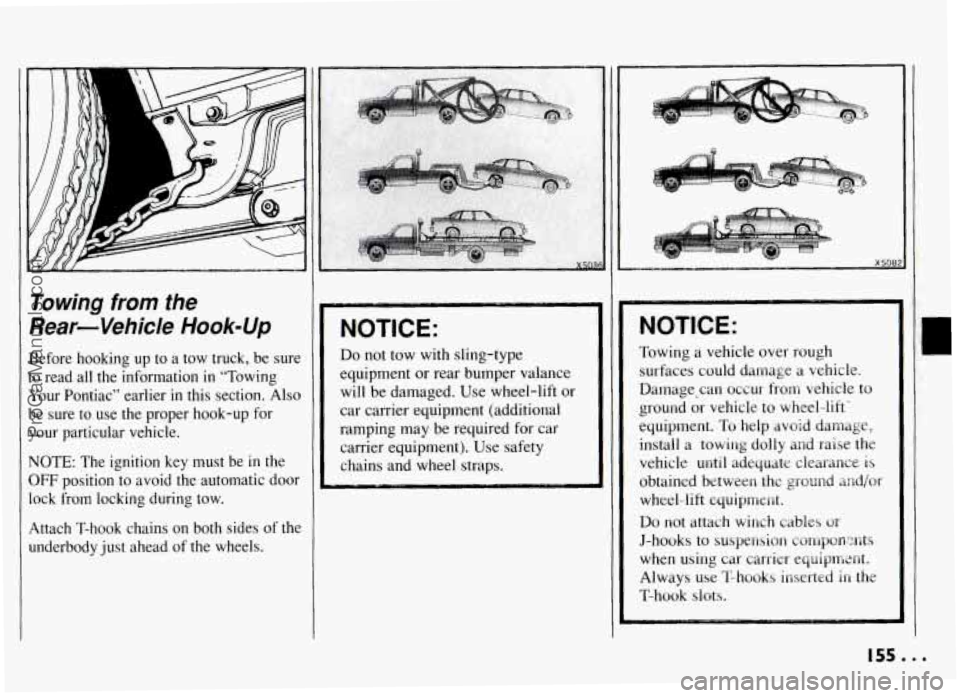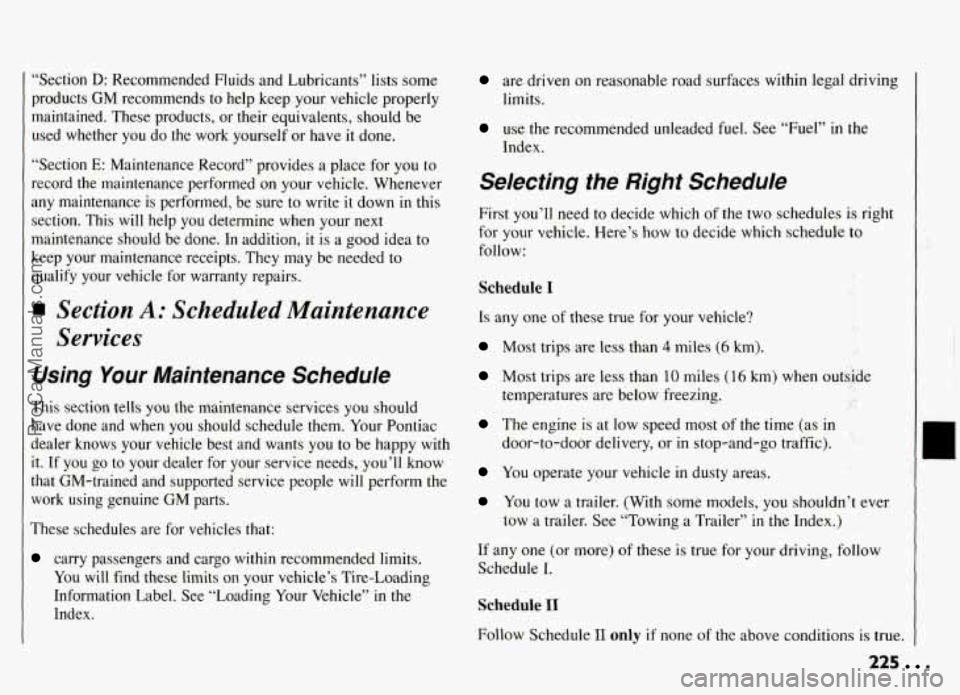Page 154 of 274

When your vehicle is being towed, have
the ignition key off. The steering wheel
should be clamped
in a straight-ahead
position,
with a clamping device designed
for towing service.
Do not use the
vehicle’s steering column lock for this.
The transaxle should be
in NEUTRAL
(N) and the parking brake released.
The ignition key must be in the OFF
position to prevent the automatic door
locks from locking during towing.
Don’t have your vehicle towed on the
front wheels, unless you must. If the
vehicle must be towed on the front
wheels, don’t go more than
35 mph
‘56 i. km/h) or farther than 50 miles
:SO km) or your transaxle will be
ilamaged. If these limits must be
:xceeded, then the front wheels have to
,e supported on a dolly.
,I 7
F
B
tc
Y
I
1
‘owing from the
?ont-Vehicle Hook-Up
efore hooking up to a tow truck, be sur(
1 read all the information in “Towing
our Pontiac” earlier
in this section.
NOTICE:
Do not tow with sling-type
equipment because fascia/fog light
damage will occur. Use wheel-lift
or car carrier equipment. Additional
ramping may be required for car
carrier equipment.
153...
ProCarManuals.com
Page 155 of 274
NOTICE: ~ ~~
Towing a
vehicle over rough
surfaces could damage a vehicle.
Damage can occur from vehicle to
ground or vehicle to wheel-lift
equipment.
To help avoid damage,
install a towing dolly and raise the
vehicle
until adequate clearance is
obtained between the ground and/or
wheel-lift equipment.
Do not attach winch cables or
J-hooks to suspension components
when using car carrier equipment.
Always use T-hooks inserted
in the
T-hook slots.
00. 154
Attach T-hook chains into the slots in the
bottom
of the floor pan, just behind the
front wheels on both sides.
Attach a separate safety chain around the
outboard end of each lower control arm.
ProCarManuals.com
Page 156 of 274

Towing from the
Rear-Vehicle Hook-Up
Before hooking up to a tow truck, be sure
to read all the information
in “Towing
Your Pontiac” earlier
in this section. Also
be sure to use the proper hook-up for
your particular vehicle.
NOTE: The ignition key must be in the
OFF position to avoid the automatic door
lock from locking during tow.
Attach T-hook chains on both sides of the
underbody just ahead of the wheels.
NOTICE:
Do not tow with sling-type
equipment or rear bumper valance
will be damaged. Use wheel-lift or
car carrier equipment (additional
ramping may be required for car
carrier equipment). Use safety chains and wheel straps.
32
NOTICE:
Towing a vehicle over rough
surfaces
could damage a vehicle.
Damage
occur from vehicle to
ground or vehicle to wheel-lift’
equipment.
To help avoid damage,
install a towing dolly and raise the
vehicle
until adequate clearance is
obtained between the ground md/w
wheel-lift equipment.
Do not attach winch cables or
J-hooks to suspension
componxmts
when using car carrier equipment.
Always
use T-hooks inserted in the
T-hook slots.
155...
ProCarManuals.com
Page 157 of 274
Problems on the Road
Towing from the
Rear-Vehicle
Hook-Up
(CONT.)
Attach a separate safety chain to each side
of the axle inboard of the spring.
Engine Overheating
You will find a coolant temperature gage
or the warning light about a hot engine on
your Pontiac’s instrument panel. See
“Coolant Temperature Gage” and
“Coolant Temperature Warning Light”; in
the Index. You will also find
a low
coolant warning light
on your Pontiac’s
instrument panel.
If Steam Is Coming From
Your Engine NOTICE:
If your engine catches fire because
you keep driving with no coolant,
your vehicle can be badly damaged.
The costly repairs would not be
covered by your warranty.
ProCarManuals.com
Page 169 of 274
Problems on the Road
NOTICE:
Spinning your wheels can destroy
parts of your vehicle
as well as the
tires. If you spin the wheels too fast
while shifting your transaxle back
and forth, you can destroy your
transaxle.
..
locking Your Vehicle to Get it Out:
‘irst, turn your steering wheel left and
ight. That will clear the area around your
ront wheels. Then shift back and forth
letween REVERSE (R) and a forward
ear (or with a manual transaxle, between
IRST
(1) or SECOND (2) and
.EVERSE
(R)), spinning the wheels as
ttle as possible. Release
the accelerator
edal while you shift, and press lightly
on
le accelerator pedal when the transaxle is
1 gear. If that doesn’t get you out after a
:w tries, you may need to be towed out.
F you do need to be towed out, see
Towing Your Pontiac”
in the Index.
ProCarManuals.com
Page 226 of 274

“Section D: Recommended Fluids and Lubricants” lists some
products
GM recommends to help keep your vehicle properly
maintained. These products,
or their equivalents, should be
used whether you do the work yourself or have it done.
‘Section E: Maintenance Record” provides a place for you to
record the maintenance performed on your vehicle. Whenever
any maintenance is performed,
be sure to write it down in this
section. This will help you determine when your next
maintenance should be done. In addition, it
is a good idea to
keep your maintenance receipts. They may be needed to
qualify your vehicle for warranty repairs.
Section A: Scheduled Maintenance
Sewices
Using Your Maintenance Schedule
This section tells you the maintenance services you should
have done and when you should schedule them.
Your Pontiac
dealer knows your vehicle best and wants you to be happy with
it. If you
go to your dealer for your service needs, you’ll know
that GM-trained and supported service people will perform the
work using genuine
GM parts.
These schedules are for vehicles that:
carry passengers and cargo within recommended limits.
You will find these limits on your vehicle’s Tire-Loading
Information Label. S’ee “Loading Your Vehicle” in the
Index.
are driven on reasonable road surfaces within legal driving
limits.
use the recommended unleaded fuel. See “Fuel” in the
Index.
Selecting the Right Schedule
First you’ll need to decide which of the two schedules is right
for your vehicle. Here’s how to decide which schedule to
follow:
Schedule I
Is any one of these true for your vehicle?
Most trips are less than 4 miles (6 km).
Most trips are less than 10 miles (16 km) when outside
temperatures are below freezing.
The engine is at low speed most of the time (as in
door-to-door delivery, or in stop-and-go traffic).
You operate your vehicle in dusty areas.
You tow a trailer. (With some models, you shouldn’t ever
tow a trailer. See “Towing a Trailer” in the Index.)
If any one (or more) of these is true for your driving, follow
Schedule I.
Schedule I1
Follow Schedule I1 only if none of the above conditions is true.
225
ProCarManuals.com
Page 227 of 274
Maintenance Schedule
Scheduled Maintenance Services Schedule I
Follow Schedule I if your car is MAINLY driven under one or more of the following conditions:
When most trips are less than 4 miles (6 kilometers).
When most trips are less than 10 miles (16 kilometers) and outside temperatures remain below freezing.
When most trips include extended idling and/or frequent low-speed operation as in stop-and-go traffic.
i When towing a trailer. (With some models, you should never tow a trailer. See “Towing a Trailer” in the Index.)
When operating in dusty areas.
Schedule I should also be followed if the car is used for delivery service, police, taxi or other commercial applications.
. 226
ProCarManuals.com
Page 232 of 274

6. Transaxle Service -- For manual transaxles, fluid doesn’t
require changing. See “Periodic Maintenance Inspections.”
For automatic transaxles, change both the fluid and filter
every
15,000 miles (25 000 km) if the vehicle is mainly
driven under one or more of these conditions:
* In heavy city traffic where the outside temperature
regularly reaches 90°F (32°C) or higher.
0 In hilly or mountainous terrain.
0 When doing frequent trailer towing.
0 Uses such as found in taxi, police car or delivery
service.
If you -do not use your vehicle under any of these
conditions, change both the fluid and filter every
100,000 miles ( 166 000 km).
7. Spark Plug Replacement* -- Replace spark plugs with
the proper type. See “Replacement Parts” in the Index.
8. Spark Plug Wire Inspection (3.1L Code M engine
only)*?
-- Inspect for burns, cracks or other damage.
Check
the boot fit at the coils and at the spark plugs.
Replace wires as needed.
9. Air Cleaner Filter Replacement* -- Replace every
30,000 miles (50 000 km) or more often under dusty
conditions.
Ask your dealer for the proper replacement
intervals for your driving conditions.
1 O.Fuel Tank, Cap and Lines Inspection”? -- Inspect fuel
tank, cap and
lines (including fuel rails and injection
assembly) for damage or leaks. Inspect
fuel cap gasket for
an even filler neck imprint or any damage. Replace parts as
needed. Periodic replacement of the fuel filter is
not
required.
* An Emission Control Service.
3- The U.S. Environmental Protection Agency or the California Air Resources Board has determined that the failure to perform this maintenance item will not nullify the
emission warranty or limit recall liability prior to the completion of vehicle useful life. General Motors, however, urges that all recommended maintenance services be performed at the indicated intervals and the maintenance be recorded in “Section E: Maintenance Record”.
ProCarManuals.com